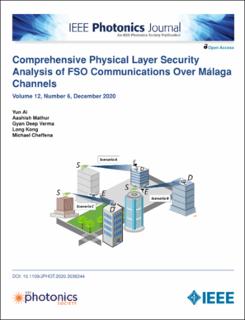Comprehensive Physical Layer Security Analysis of FSO Communications over Málaga Channels
Peer reviewed, Journal article
Published version

Åpne
Permanent lenke
https://hdl.handle.net/11250/2712077Utgivelsesdato
2020Metadata
Vis full innførselSamlinger
Originalversjon
10.1109/JPHOT.2020.3036244Sammendrag
In this paper, we study the physical layer security of free-space optical (FSO) communications under different eavesdropping scenarios. More specifically, the secrecy performance of FSO communication employing intensity modulation/direct detection detection is analyzed for the well-established Málaga channels. Three different realistic scenarios of eavesdropping are considered by assuming different placement locations for the eavesdropper in the paper. Novel expressions for the average secrecy capacity (ASC) and secrecy outage probability (SOP) are derived for the considered scenarios, and useful insights are also provided through asymptotic analysis. The results show: (i) When the eavesdropper is placed near the transmitter, atmospheric condition imposes a less significant impact on secrecy performance; (ii) Certain level of correlation can potentially enhance the secrecy performance for FSO communications; (iii) The correlation imposes opposite impacts on the ASC and SOP of FSO communications; and the secrecy performance metrics exhibit a non-monotonic impact with the increase of correlation; (v) When the correlation of the FSO links is too small or too large (i.e., the correlation parameter around 0 or 1), the correlation plays a more significant impact on secrecy performance; and (vi) The asymptotic slope of the SOP is 0.5 for all eavesdropping scenarios under practical FSO channels.
